Ajax wouldn’t be Ajax, if not for how well their academy is set up. It wouldn’t be possible for the team to end up Eredivisie champions year after year if not for the amount of talent they constantly keep producing to fill in the shoes of players who move out of the club during every transfer window. One such talent is the 19-year-old Kenneth Taylor who has been training in Ajax’s academy right from the age of eight after moving in from De Foresters Youth where he was scouted to play as a striker.
In this scout report, we will be looking at Kenneth Taylor, who captained the U-17 Dutch national team which went on to win the European Championship in the year 2019 and is also someone who idolises the former Liverpool player Georginio Wijnaldum. We will perform an analysis of his tactics, abilities both off and on the ball and in different phases of the game with a special section analysing why the player is dubbed as the next Toni Kroos.
Throughout this tactical analysis piece, for the purpose of understanding, Kenneth Taylor would be marked red and other players grey in all the visualisations used in this piece.
Player Overview
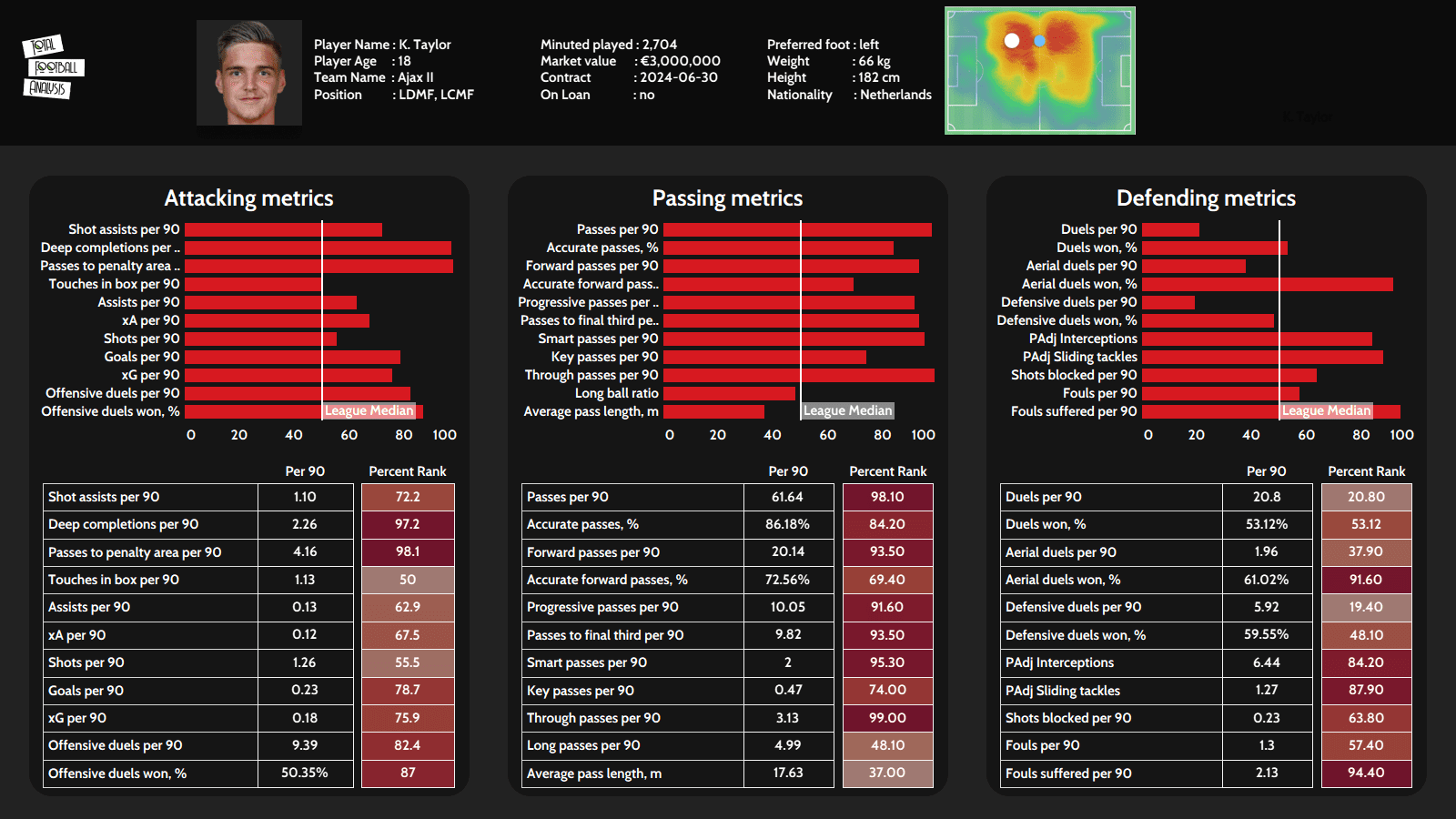
Taylor, who has played the majority of his matches for Ajax II, made his first appearance for the senior team in November 2020 and is expected to play a significant role in the upcoming season for Erik ten Hag’s men. Taylor plays a deep ‘8’ role and prefers to operate down the left half of the pitch. Although the player’s preferred foot is left, one who watches him play for the first time would have a hard time predicting his stronger foot.
He plays an important pivot role by acting as the bridge that connects defenders to the attackers. Along with this, Taylor also possesses strong attacking qualities and equal defensive abilities which makes him a complete player at the age of 19. The player possesses excellent spatial awareness and positional play with a very strong mentality which helps him stand out from the rest of his peers.
Analysis of Kenneth Taylor’s pivotal role
The Dutch champions’ go to formation is the 4-2-3-1 where they play a double pivotal tactical system in which Taylor is played alongside Donny Warmerdam and plays as a solo pivot in a 4-3-3 formation.
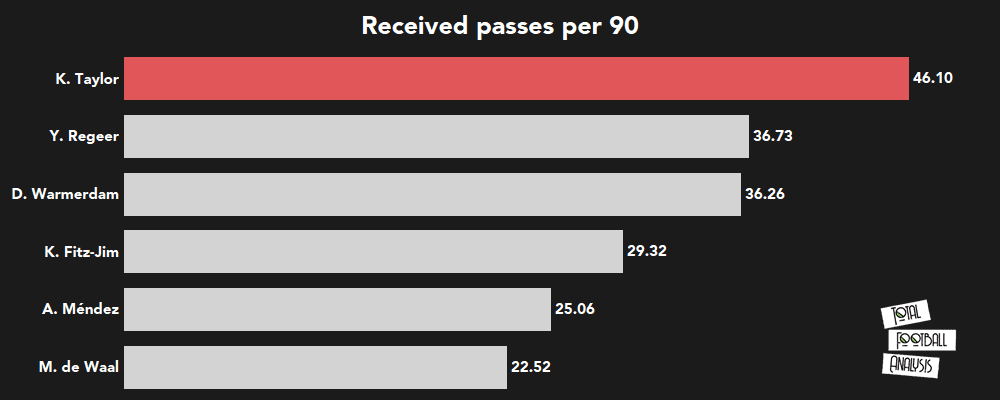
From the bar chart, we can see that Taylor is who has received the most number of passes(46.10) among the midfielders – pretty much explaining his pivotal role in linking up the team’s defenders and attackers. Also looking at the heatmap from the player profile, one would notice how he occupies the space in front of defenders.
His spatial awareness, as mentioned above, is really good which helps him easily bypass an opponent’s press when building up. He constantly checks over his shoulders to scan the field and assess the situation and quickly decides what to do – explaining how quick his decision making is.
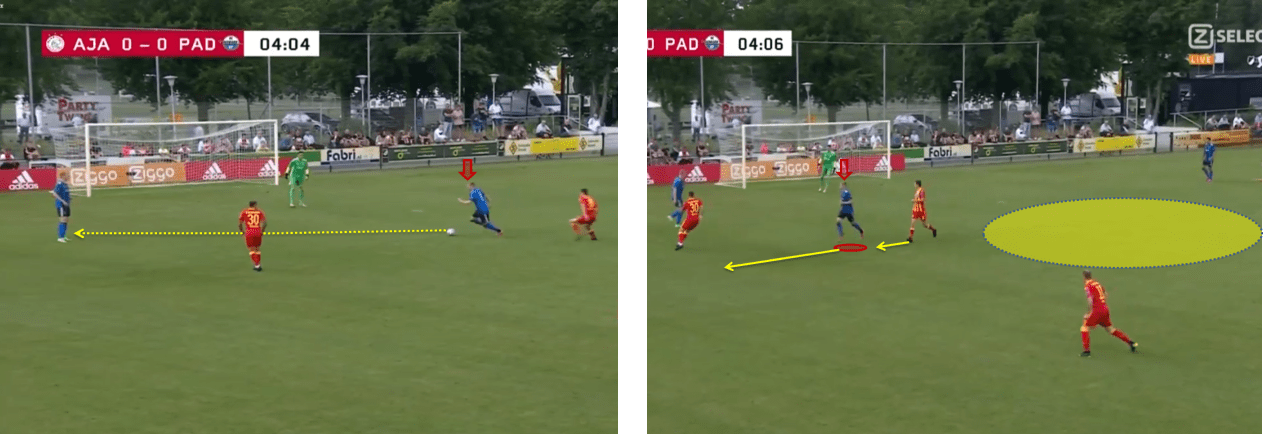
In the first image from left to right, we can notice that Taylor is aware that he’s being approached and immediately takes his first touch towards his left, dragging his opponent in that direction. In the second image, we notice that he continues to move to the left dragging the opponent and hence creates a huge space in the middle to progress.
The maturity that the player shows on the field at the age of 19 is unmatchable and it’s what could make Taylor the next great midfielder of the Netherlands. Taylor not only plays an important role in escaping the press or building up from the back, but he’s also vital in the team’s performance in the attacking third. Playing a double pivotal role has given the player free license to combine with the attack without having to worry about guarding the goal as it’s covered by the other defensive midfielder.
Progression and Influence in the final third
Taylor is an attacking-minded midfielder. He was initially scouted by his previous team to play as a striker and it’s at Ajax that they discovered his potential and thought he could offer a lot more by playing behind.
When in possession, Taylor looks for the best attacking option possible on the field and is also concerned about losing possession. An average of 61.64 passes per game with an accuracy of 86.18% is impressive given that the player looks to take risks when passing.
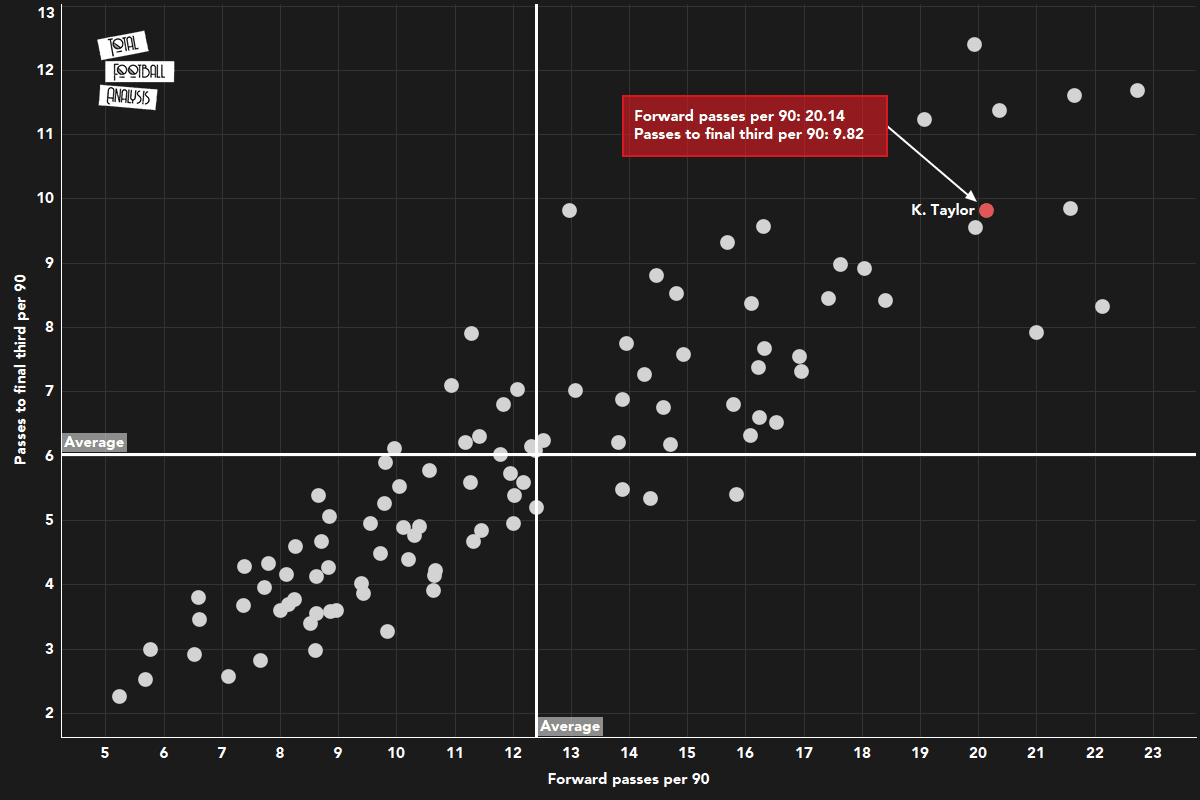
The scatter plot shows where Taylor stands in terms of his progression ability. While a forward pass is a pass when a player passes the ball forward without really causing any impact, a player who plays as deep as Taylor can accumulate a lot of forward passes without really causing influence in the attacking third. But as one can see from the plotter, Taylor does top that chart in both forward passes and passes into the final third with an approximate ratio of 2:1, indicating for every two forward passes that he makes, one of them is passed into the final third.
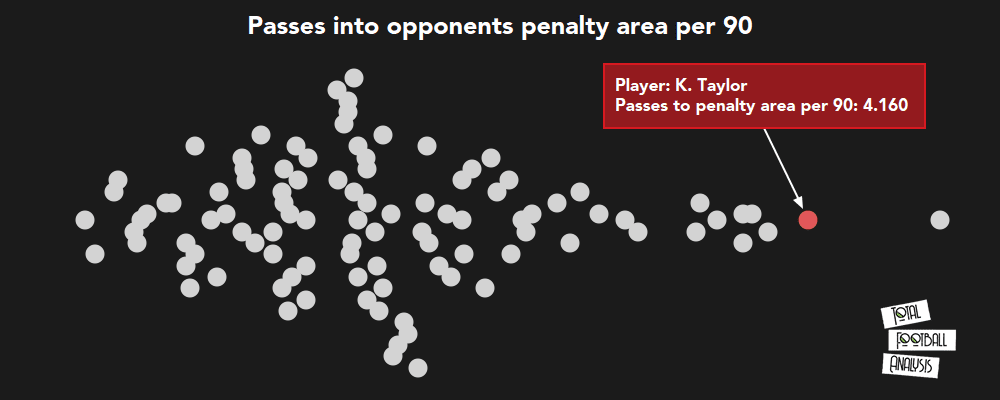
To analyse his influence even further in the attacking third, one can see from the above beeswarm plots that Taylor stands second in terms of passes into the penalty area per 90 with an average pass count of 4.16 per 90. What makes these numbers look promising is his pass completion percentage in spite of the player attempting so many dangerous passes in the final third. It’s also important to note that the player not only is involved in the build-up but also plays a vital role in terms of final passes for his team indicating his versatility and strong mentality.
The fact that the player is equally strong with both his feet is an asset to his playstyle as it makes him unpredictable and also influences his quick footwork. In terms of playmaking, Taylor really doesn’t have any problem distributing to either side of the pitch since he’s good with both his feet.
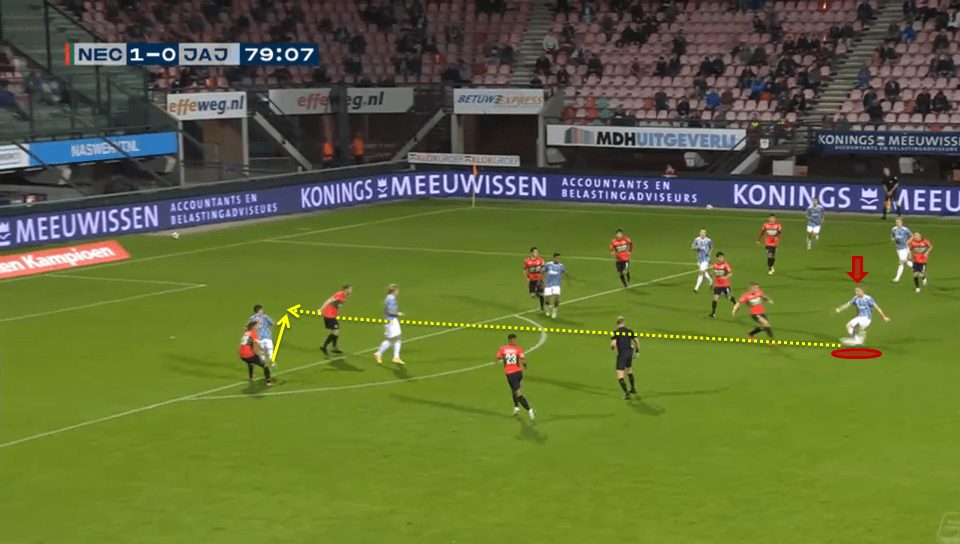
His spatial awareness has always been vital since he not only is aware of the position of the opponents but also knows where his players are and always manages to pick their runs. From the image, we can see Taylor identifying the run by his teammate and opting for a through ball. His weight and timing of the passes are really good which as a result helps the pass reach the receiver without any interruption. He on average creates 1.2 chances per 90 which have a conversion rate of 62% which indicates his quality of passes.
Taylor is the kind of player who looks to make the maximum out of even a small opportunity put in front of him. In confined spaces, he plays safe and sometimes opts to dribble past comfortably with his very good footwork. Taylor’s duty does not end with just escaping the press, building up and creating chances as he also plays a vital role in transition to defence in order to win back the lost balls.
Defensive abilities
Upon losing possession in the final third, Taylor is quick to close down and recover the ball immediately. He revolves outside the penalty area waiting to win the second ball like these and quickly regains possession. Around 44% of his recoveries came from the final third.
Back in the defending third, Taylor is a different player who is calm and never hasty. One quality skill of the player is to know when to go for the challenge and when not to. He quickly accelerates and closes down the ball receiver and closes down their angle.
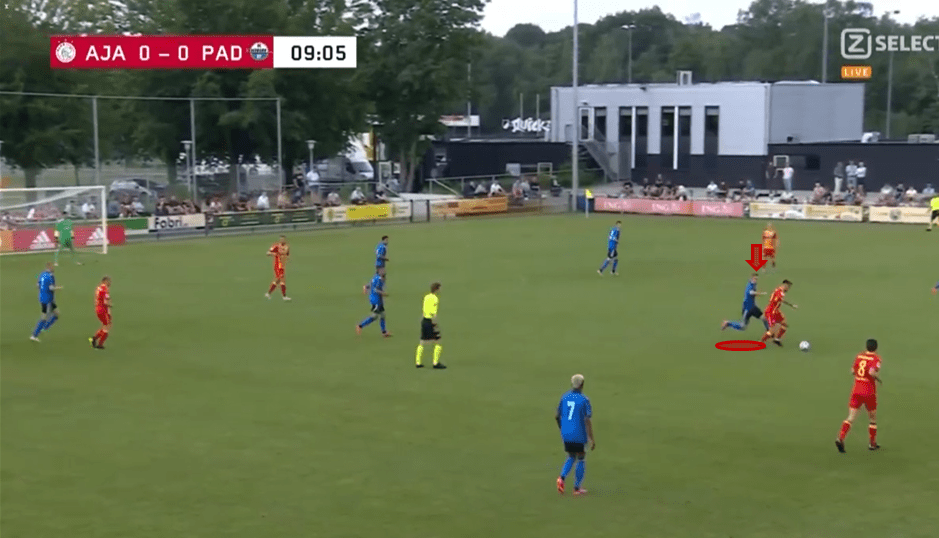
In the match image, we can see Taylor closing down and pressing a player giving him no space and time to turn and face the target. As a result, the ball possessor with no option left is forced to play back. Taylor is well aware of the danger that he can put his team in if he gets defeated and which is exactly why the player never charges for a tackle unnecessarily and instead holds them and forces them to play another option.
When in not possession, Taylor plays a very good positional game knowing where to move and when to move. He pretty much dictates the game and is responsible for filling in the voids in the defending third. He also indirectly puts pressure on the ball possessor by closing down all the possible passing lanes.
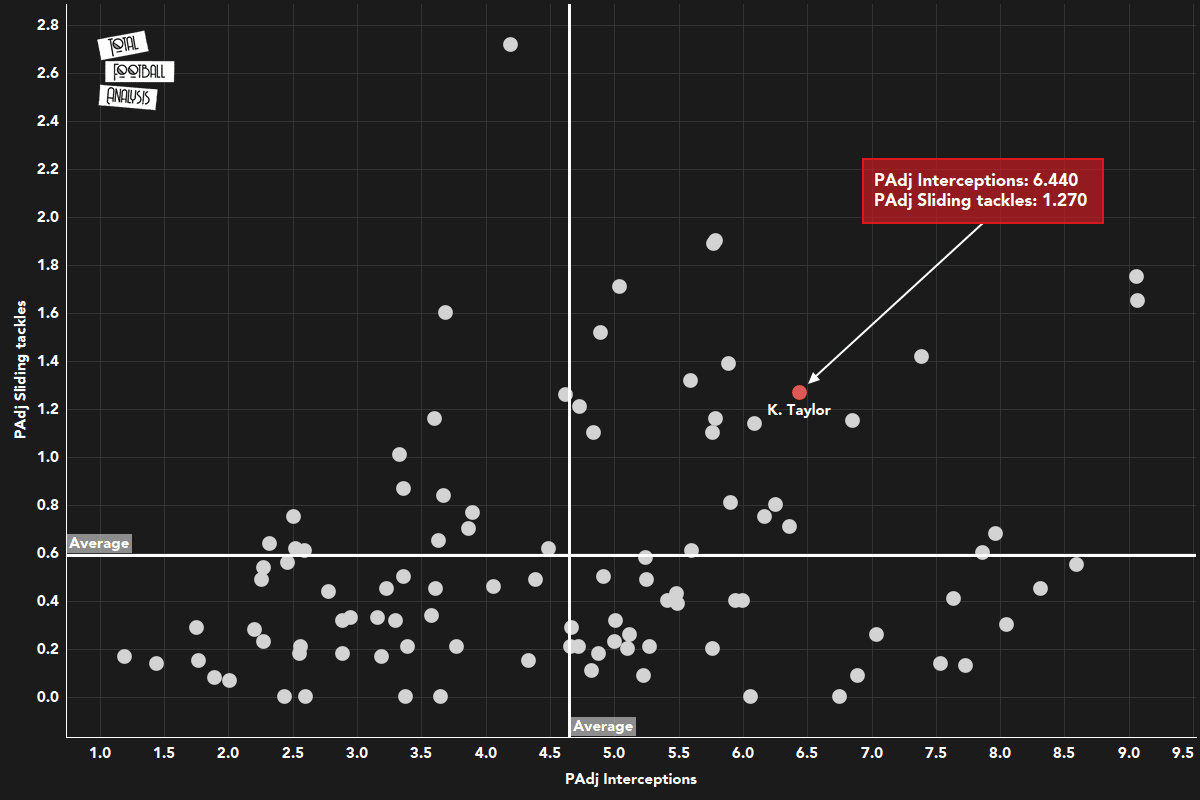
The scatter plot indicates the recoveries that the player has made on an average in the match and one can see Taylor manages to excel in both the metrics which were used in the scatter. He on average manages to intercept 6.44 passes per 90 and also attempts as much as 1.27 tackles per 90 which both are above average by a comfortable margin.
His ability to anticipate what the opponents are going to do next is key to his performance in the defensive duties. On anticipating the next action, Taylor prepares himself accordingly which puts him on the front foot and helps him in regaining possession.
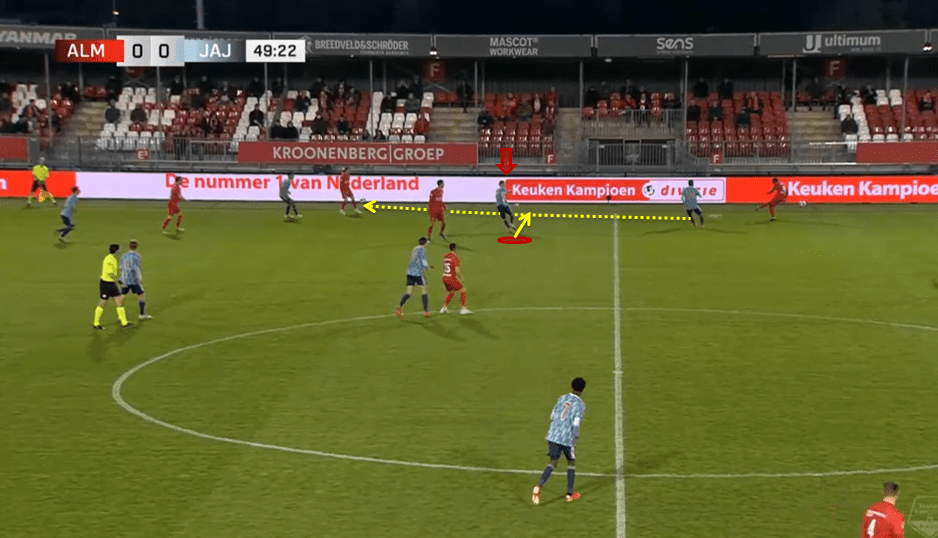
We can see from the image, Taylor has anticipated the pass earlier and is quickly going to intercept the ball and regain possession. Although the ball receiver is already under pressure by his teammate which could possibly result in loss of possession, Taylor who mentioned earlier looks to make the most out of any opportunity provided and hence decides to intercept the ball without giving away any chances to the opponents. He also is very good and dominant in the air, winning the majority of the aerial duels in the mid-third.
In comparison to Toni Kroos
Taylor is quite often compared to Kroos for his style of play when in possession. If you look at their heatmaps, it’s pretty clear that they both operate in the same areas of the pitch.
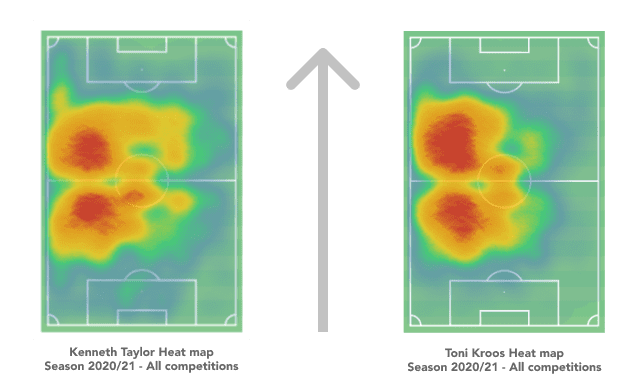
Both Kroos and Taylor play a similar role when in possession and look to find the best attacking option possible and at the same time play safe. In fact, the 19-year-old could go on as a replacement to Kroos at Real Madrid in the future.
Looking at their metrics for attacking and creativity in the upcoming radar we see that it supports our belief that both of them are similar when in possession.
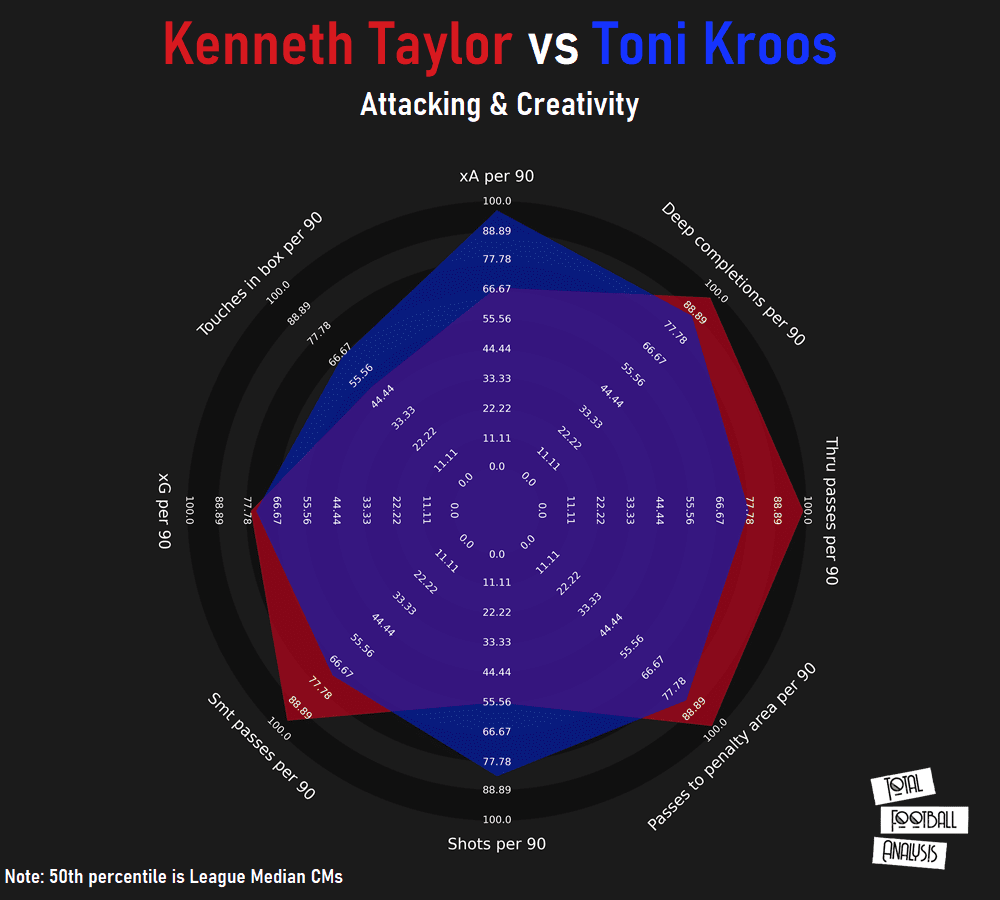
We can see that the radars pretty much resemble a similar shape indicating their similarity. In reality, Kroos does take a lot of shots from outside the box when compared to Taylor who has seven goals to his name this season. Taylor doesn’t look to bang in the long shots, but rather passes the ball calmly into the goal when inside the penalty area. Taylor looks to have higher percentiles in quite a number of metrics.
When looking at the passing and progression metrics of these two players, we can see that they still look similar- further supporting the statement of their similarity.
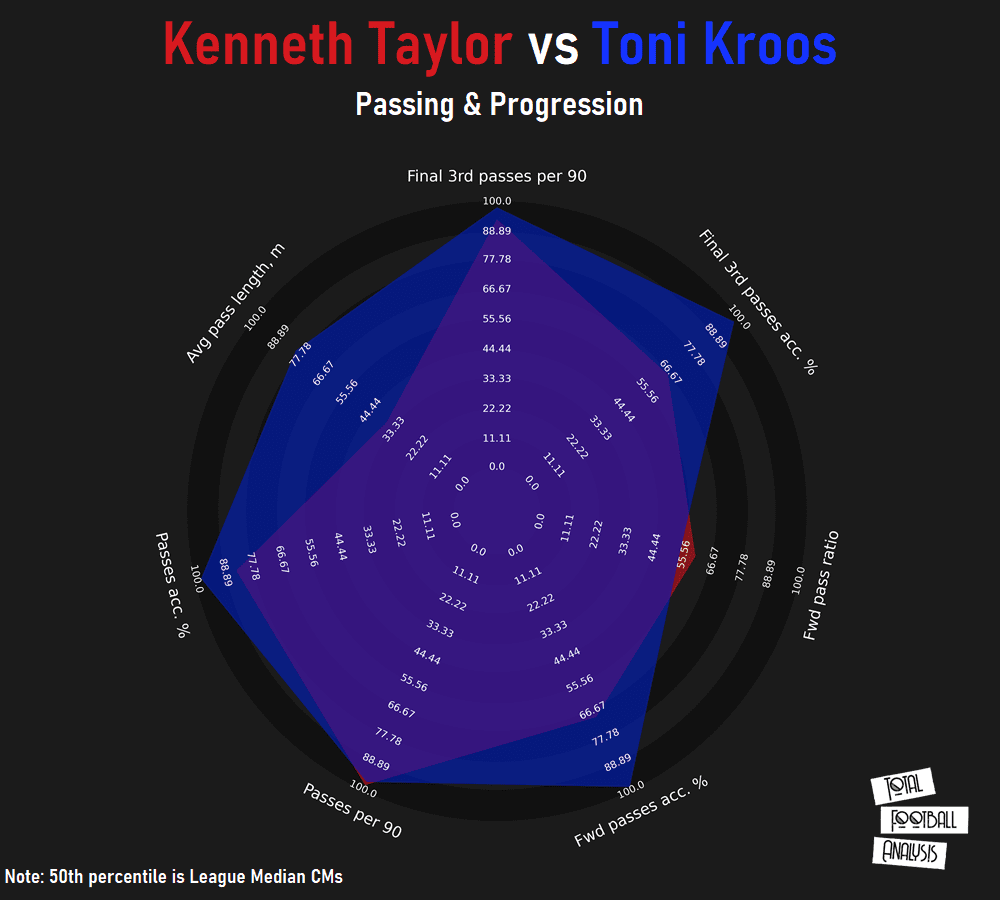
Kroos looks to have a greater impact in terms of passing and progression ability but Taylor looks no less when compared to him. The only possible major difference that can be noticed is the average pass length of both the players, but it really shouldn’t matter since it depends on the nature of the league.
As a result, it’s understandable that Taylor is compared to Kroos. They both are very similar in terms of playstyle which is also supported by our data check. With proper development of the player, Taylor can still go a lot further.
Conclusion
Taylor possesses great abilities and has been a stand out midfielder so far. Although the player has already made his first-team debut last season having played very few minutes without any major impact, it’ll be interesting to see how he performs this season in the first team and how he adapts to the competitiveness and requirements of the top tier league in the country.
Manchester City has already expressed their interest in the player followed by other European giants. Taylor has managed to excel at both his tactical and technical ability at a very young age which now helps him to focus on improving his standards and game. The 19-year-old is surely destined for a great future if he continues to stay humble and evolves constantly.



Comments